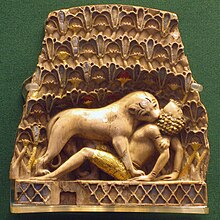Levantine ivory carving
As the Levantine ivory carving tradition , the Near East Archeology describes a tradition of the ancient oriental ivory carving of the first millennium BC. Next to the northern Syrian and the Assyrian ivory carving tradition .
Locations
Like most of the ancient oriental ivories, the work of the Levantine carving tradition was found during the excavations in Nimrud , Iraq . In addition, the Turkish Arslan Taş is of particular importance. Other sites are Ḫorsabad , Qal'at Šerqat , Harran , also Raʾs Šamra , Tell Kāmid el-Lōz , Tell ed-Duwer and Tall al-Mutasallim . Individual specimens have been found in Ialysos and Lindos on Rhodes , Samos , Crete , Perachora in Greece and Paeneste in Etruria . All in all, the Levantine ivory carving tradition is the most widespread and best-known ancient oriental ivory carving tradition and is often simplified by neighboring sciences and equated with ancient oriental ivory as a whole.
term
The stylistic peculiarities of the ivory found in Nimrud suggested that the work was not made there, but was brought there as tribute or war booty . Based on stylistic features known from Egyptian art on the one hand and comparisons with pieces found during excavations in northern Syrian and Assyrian sites on the other, the classification of ancient oriental ivory, which is still valid today, was developed in 1912.
Quirks
The Levantine ivory carving tradition is based on Egyptian pieces, but shows variations compared to the Egyptian shapes. The pieces are predominantly furniture inlays in the form of low and high reliefs with frequent À jouré work . But there are also pyxids and statuettes . Levantine works in particular are considered an expression of particular skill.
literature
- Richard D. Barnett , Fine Ivory Work , in: Charles Singer (ed.), A history of technology , Oxford 1954, 663-668.
- Georgina Herrmann , Ivory Carving of the first millenium workshops, traditions and diffusion , in: Christoph Uehlinger (ed.), Images as media. Sources for the cultural history of the Near Eastern Mediterranean (= OBO 175), Friborg, 267-282.
- Dirk Wicke , small finds made of ivory and bones from Assur (= WVDOG 131), Wiesbaden 2010.
